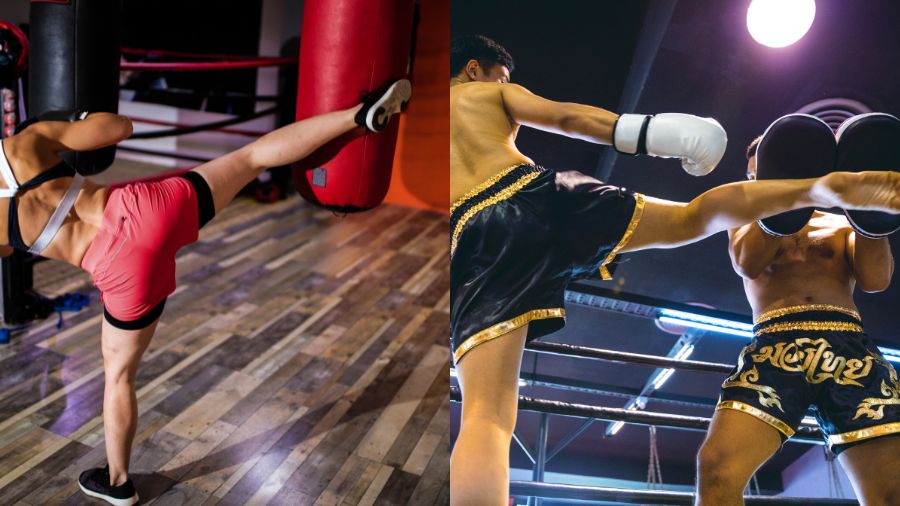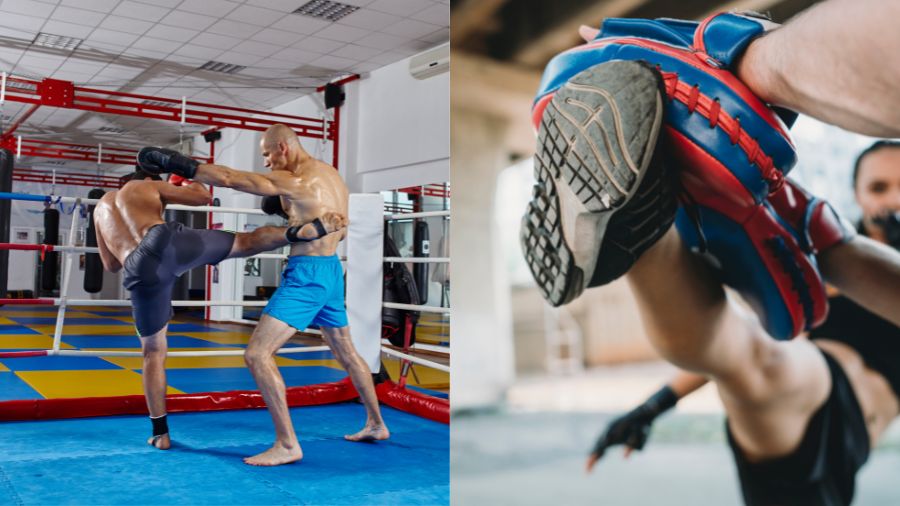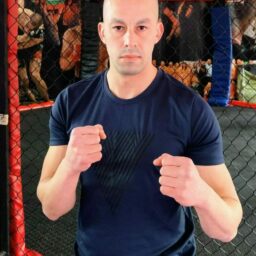There are many forms of kickboxing, each with its unique interpretation of punching and kicking. Two of the most distinct ones are Savate and Muay Thai, the respective combat sports of France and Thailand.
The main difference between Savate and Muay Thai is in the kicking. In Muay Thai, fighters are barefoot, and kicks are delivered predominantly with the shin. In Savate, practitioners wear shoes, and only foot kicks are allowed.
Of course, these two traditional combat sports have many other subtle differences. Let’s dive in and investigate what sets these two great martial arts apart.
What Is Savate?
Savate began in the back alleys of 18th-century France. The word savate is an old French word and means shoe or an old boot, and it tells of the style’s reliance on foot kicks as its primary weapon.
Sailors and thugs used traditional Savate for street fighting. It used the heavy shoes used by sailors and the military as a weapon while kicking. Another form of kick-centric fighting called Chausson was developed simultaneously, and both were used as self-defense techniques.
The first man to open a school to teach and promote a regulated version of Savate was Charles Lecour in 1825. These initial forms of combat did not include closed fist punches. Only slaps and hand thrusts, but after Lecour was introduced to English boxing, significant changes were made to Savate to incorporate proper punching.
After Savate was codified as a ring sport in the late 19th century, it quickly gathered fame and reached its heyday in the days before the Second World War. It was a demonstration event at the 1924 Olympics in Paris.
Today, the French kickboxing system is well known worldwide. However, it’s not one of the widely available martial arts like Muay Thai. Savate is an exciting form of kickboxing, utilizing unique kicking sequences and attacks. It is also one of the few kick-based combat sports that use shoes in competition.

How to Dominate Every Fight with Raw, Explosive Power No One Can Match
Discover the underground blueprint that has quietly turned MMA hopefuls into legends, using nothing but sheer, brute force and bulletproof conditioning techniques.
Here is a beautiful demonstration video encompassing Savate’s historical aspect and modern combat sports form.
What Is Muay Thai?
Muay Thai, also known as the art of 8 limbs, is Thailand’s national sport and martial art. It originated on the battlefields of 13th century Thailand (then the Sukhothai Kingdom). It was used both by soldiers and for entertainment and ritual tournaments.
Muay Thai adopted western boxing elements, such as the ring, boxing gloves, and round division, which was first formalized in the early twentieth century.
Muay Thai is a vicious striking style utilizing punches, kicks, elbows, knee strikes, and clinching techniques. What separates it from other contemporary styles is the emphasis on tradition. Some recognizable elements are that each fight begins with a ritual dance and is fought under traditional music called Sarama.
Muay Thai became famous in the 1990s and early 2000s when Thai fighters started fighting in K1 kickboxing tournaments. MMA fighters discovered the brutal striking efficiency it provided. Today, Muay Thai has a well-developed scene worldwide, both as a separate sport and an essential pillar in mixed martial arts.
Key Differences Between Savate and Muay Thai

Rules
Muay Thai fights are held in a square ring for 5 rounds of 3 minutes. Punches, kicks, elbows, and knees are allowed, as well as extensive clinching.
Kicks are better rewarded than punches. Trips, sweeps, and dumps both from a distance and in the clinch are favorable in front of the judges. A fight is won either by a knockout or a scorecard decision.
Savate competitions have two rules: “assault” and “total combat.” In assault matches, competitors wear protective gear and score points, much like in light contact kickboxing. Total combat is a full-contact ruleset where the knockout is the most desired outcome of a fight.
Punches and kicks of all levels, as well as jumping and spinning kicks, are permitted. The most important aspect of Savate rules is that all kicks must land solely with the shoes.
Of course, in a full-contact match, it is difficult to follow this rule completely. Accidental kicks with the lower shin are tolerated. Still, as a rule, only the foot (including the heel and sides of the shoes) must make contact with the opponent.
Equipment
The official Savate uniform includes long pants, sleeveless tops, boxing gloves, and, most notably, special shoes. The shoes gave the name to the martial art and are extensively used as a weapon.
Muay Thai fighters wear only Thai shorts and Muay Thai gloves and fight barefoot during competition.
Techniques
Punching in both sports comes from western boxing and utilizes the same basic strikes like the jab, cross, hook, and uppercut. But in general, punching in Savate is more relied upon, whereas in Muay Thai, it is more rudimentary.
The most significant difference between the two is the kicks. A Muay Thai kick is intended to land with the shin, and the overall body motion is like swinging a baseball bat. In stark contrast, the Savate kick is snapped fast like a whip and must land with the foot.
Savates’ kicks are more versatile because the snapping motion lets you kick multiple times with the same leg without stepping on the ground.
Savateurs also kick with more precision and use a lot of different angles, both in their kick trajectories and in their position in relation to the opponent, much like boxers do with their punches.
Where savateurs specialize in various kicks, Nak muay are experts at clinching. They are very proficient in striking from up close and throwing or tripping their opponents.
Footwork and Stance
There is a very different approach to the stance and footwork in Muay Thai and Savate. Muay Thai fighters usually fight more stationery and are flat-footed. They prefer not to retreat too much but to block and immediately deliver a counter-attack.
The traditional Thai stance places most of the weight on the back leg and puts the hands very high to better block incoming elbows or to engage in a clinch.
Savate footwork is very dynamic. The feet are used as rapiers and constantly move, feint or attack. Savate fighters tend to stay light on their feet and move around quite a bit, and the stance is more balanced because of this.
Savate vs. Muay Thai For Self Defense

Muay Thai and Savate hold several distinct advantages in self-defense applications. The unrivaled clinch skills of Muay Thai fighters are invaluable on the street, where fights often get close and dirty.
Elbows and knees are also very devastating in close range. Thai fighters are also notoriously durable; few can argue this is an essential trait, even for self-defense.
The French martial art, on the other hand, brings fast punches and kicks, capable of disposing of opponents instantly. Additionally, Savate evolved from street fighting systems and extensively uses shoes as a weapon.
Kicking with the heel, side of the sole, or rigid shoe toes is extremely dangerous. Savateurs practice those kicks extensively, making them ideal for real-life scenarios where you will most likely be wearing shoes.
Savate vs. Muay Thai For MMA
Both Savate and Muay Thai have a lot to offer to MMA athletes. The important part is that both are full-contact competitive combat sports, meaning competitors fight with full force.
The physical and mental toughness gained through real sparring and fighting is a mandatory trait every MMA fighter must have. Savate and Muay Thai develop that.
As for the technicalities, we’ve seen mobile kickers and heavy Thai stylists have great success in the cage in this era of MMA. As a result, both combat sports can serve as a solid foundation for developing a complete mixed martial arts skill set.
A downside of Savate in MMA and kickboxing is that there are no shoes. And where kicking with hard shoes is vicious, the same techniques with bare feet can harm the kicker.
Savate vs. Muay Thai: Who Would Win?
The most crucial point that has to be made in the direct battle between Savate and Muay Thai is the ruleset. There have been a few fights between the two styles, and they usually go the way of the savateur, but they have been under kickboxing rules, which favor them.
A lot of emphasis in Muay Thai is placed on clinching and elbow strikes. When you take those away, you rob the Muay Thai fighter of some of his best weapons.
However, under these rules, savateurs were required to fight barefoot. The art evolved around kicking with shoes, which disadvantaged them.
In my opinion, Savate and Muay Thai are very even in a one-on-one fight. In an unrestricted stand-up fight, each fight can go either way. The power, knees, and elbows of Nak Muay are just as dangerous as Savate fighters’ dynamic precision kicking and slick punching abilities.
A great fight in favor of Savate is David Hergault vs. Francois Pennacchio. It is a perfect illustration of the different approaches of both sports. The savateur Pennacchio is much more mobile and dynamic. At the same time, Hergault is more flat-footed and relies on single heavy shots.
The kicking game of Pannacchio, in particular, is an excellent example of how the Savate-specific kicks work in a kickboxing context.
Another good fight featuring a pure Thai stylist vs. a Savate practitioner.
Should You Learn Savate Or Muay Thai?
Look into both martial arts a bit deeper and choose the one you like more. That said, chances are people reading this article won’t have a Savate gym nearby. At the same time, there is probably a Muay Thai one.
Competitions in Thai art are also significantly more developed. So, unless you are in France or some other country with a Savate federation, this sport is unlikely to be your first choice. But if you have access to both, it’s all down to personal choice and preference. You won’t be wrong regardless of which you choose.

